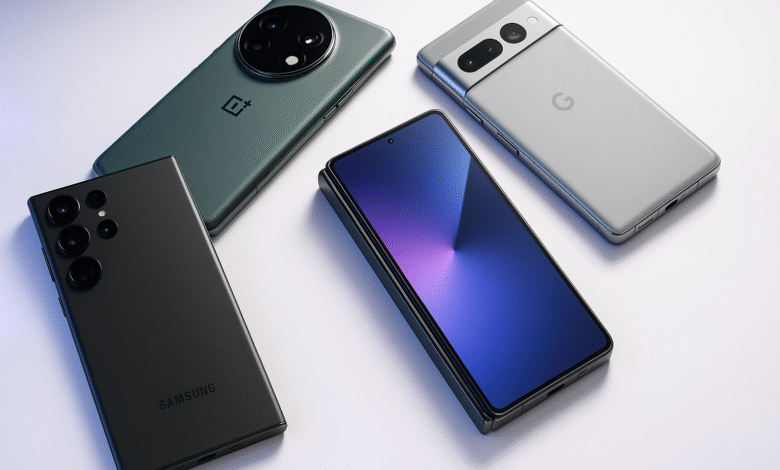
Finding the best Android phone in 2025 feels different than it did just a few years ago. The market has matured in ways that actually benefit you as a buyer. Whether you’re looking for cutting-edge camera technology, all-day battery life, or simply the best value for your money, the current crop of Android smartphones delivers on nearly every front.
This year’s lineup includes some genuinely impressive devices. Samsung continues pushing boundaries with its Galaxy S series. OnePlus has made a remarkable comeback with pricing that undercuts competitors by hundreds of dollars. Google’s Pixel phones keep getting better at computational photography. And foldables have finally become practical enough for everyday use.
The beauty of Android in 2025 is that you don’t need to spend $1,200 to get a great phone. Sure, flagship phones offer premium features, but mid-range options now include specs that were exclusive to high-end models just two years ago. Whether your budget is $400 or $1,400, there’s a phone that’ll work for you.
In this guide, I’ll walk you through the best Android phones of 2025, breaking down what makes each one worth considering and, just as importantly, who should skip them. Let’s find your next phone.
What Makes the Best Android Phone in 2025?
Before diving into specific models, it’s worth understanding what separates a good Android phone from a great one in 2025.
Performance and Processing Power
The Snapdragon 8 Elite processor has become the gold standard for flagship phones this year. This chip delivers performance that rivals desktop computers from just a few years ago. For most people, any phone with a Snapdragon 8 series chip or Google’s Tensor G5 processor will handle everything you throw at it.
Camera Quality That Actually Matters
Camera quality remains one of the biggest differentiators. The best phones now feature multiple lenses with real utility, not just padding the spec sheet. Look for phones with a solid main sensor (50MP or higher), a useful telephoto lens for zooming, and computational photography that makes your shots look professional without effort.
Battery Life and Charging Speed
Nothing ruins a phone faster than dying by mid-afternoon. The best Android phones 2025 pack batteries between 5,000mAh and 6,000mAh, easily lasting a full day even with heavy use. Fast charging has also evolved, with some phones reaching 50% charge in just 15 minutes.
Software Updates and Longevity
Here’s where things have improved dramatically. Major manufacturers now offer up to seven years of software updates. This means your phone stays secure and gets new features well into 2030. This longevity makes spending more on a quality device actually make financial sense.
The Best Android Phones of 2025: Our Top Picks
Samsung Galaxy S25 Ultra: The Complete Package
The Samsung Galaxy S25 Ultra represents everything a premium Android phone can be. With its massive 6.9-inch AMOLED display, this phone commands attention. The Snapdragon 8 Elite processor delivers blazing performance, whether you’re editing videos or playing demanding games.
Key Features:
- 200MP main camera with 100x Space Zoom
- 6.9-inch QHD+ AMOLED display with 120Hz refresh rate
- Built-in S Pen for productivity and creativity
- 5,000mAh battery with fast charging
- Seven years of software updates
- IP68 water and dust resistance
The camera system deserves special mention. That 200MP sensor captures an absurd amount of detail, and the 100x zoom actually produces usable results. The S Pen remains a unique feature in the Android flagship space, turning your phone into a genuine productivity tool.
Who Should Buy It: Creative professionals, power users who want the absolute best, anyone who values the S Pen for note-taking or sketching. According to Android Central, it remains a top contender for the best overall Android phone.
Who Should Skip It: Budget-conscious buyers (it starts at $1,299), people who find large phones uncomfortable, anyone who wants the lightest possible device.
OnePlus 13: Exceptional Value Meets Flagship Performance
The OnePlus 13 might be the smartest phone purchase you can make in 2025. At $899, it undercuts competitors by $400 while matching or exceeding their specs. This phone proves you don’t need to drain your bank account for flagship phone performance.
Key Features:
- Snapdragon 8 Elite processor
- Massive 6,000mAh silicon-carbon battery
- 100W SuperVOOC fast charging (0-50% in 13 minutes)
- IP69 rating (highest water and dust resistance available)
- 50MP triple camera system
- Four years of OS updates, six years of security patches
The battery life on this phone is genuinely impressive. That 6,000mAh capacity, combined with efficient power management, means you’ll easily get through a full day of heavy use. The charging speed makes topping up during lunch a viable strategy.
Who Should Buy It: Value-focused buyers who still want premium specs, anyone tired of battery anxiety, users who want flagship performance without flagship pricing. Android Authority gave it the highest rating they’ve ever awarded a smartphone.
Who Should Skip It: Camera enthusiasts who need the absolute best photo quality, people heavily invested in other ecosystems, anyone who needs the longest software support.
Google Pixel 9 Pro XL: The Camera Champion
If photography is your priority, the Google Pixel 9 Pro XL delivers results that consistently wow. Google’s computational photography remains unmatched, turning average shots into Instagram-worthy photos. The Tensor G4 processor might not benchmark as high as Snapdragon, but it powers AI features that actually feel useful.
Key Features:
- Industry-leading computational photography
- 6.8-inch LTPO OLED display
- Seven years of guaranteed software updates
- Clean Android experience with exclusive AI features
- 5,060mAh battery
- Face unlock and fingerprint sensor
The camera quality here isn’t just about megapixels. Google’s AI processing handles tricky lighting, reduces blur, and even erases unwanted objects from photos. The Night Sight mode produces low-light shots that look impossibly good.
Who Should Buy It: Photography enthusiasts, users who value software updates, anyone who prefers clean Android without manufacturer bloatware, people interested in AI features.
Who Should Skip It: Gaming enthusiasts who need maximum raw performance, users who want the fastest charging speeds, budget-conscious buyers.
Samsung Galaxy Z Fold 7: The Productivity Beast
Foldable phones have finally hit their stride, and the Samsung Galaxy Z Fold 7 leads the pack. When unfolded, that 7.6-inch display transforms your phone into a mini-tablet, perfect for multitasking, reading, or watching content. This year’s model is notably thinner and more durable than previous generations.
Key Features:
- 7.6-inch main display, 6.3-inch cover screen
- Enhanced durability with improved hinge design
- Snapdragon 8 Elite processor
- DeX mode for desktop-like productivity
- 4,400mAh battery
- Flex Mode for hands-free use
The foldable phone category finally makes sense for more than just early adopters. The Z Fold 7 excels at multitasking, letting you run three apps simultaneously. Reading articles, reviewing documents, or watching videos all benefit from that large screen.
Who Should Buy It: Productivity-focused users, content consumers who want a bigger screen, professionals who want laptop-like capabilities in their pocket, tech enthusiasts.
Who Should Skip It: Budget shoppers (it starts at $1,899), people who prefer compact phones, anyone concerned about long-term durability.
Google Pixel 9a: The Budget Winner
Not everyone needs to spend $1,000+ on a phone. The Google Pixel 9a proves that budget Android phones can deliver excellent experiences. At around $399, this phone includes features that used to be exclusive to flagships.
Key Features:
- Tensor G4 processor (same as flagship Pixels)
- Excellent 64MP main camera
- Seven years of software updates
- Clean Android 15 experience
- 5,000mAh battery
- 6.3-inch OLED display with 120Hz refresh rate
The value for money here is outstanding. You’re getting flagship-level performance, Google’s excellent camera processing, and the same long-term software updates as phones costing twice as much. The compromises are minor: slower charging, slightly less premium materials, and no wireless charging.
Who Should Buy It: Budget-conscious users who don’t want to compromise on essentials, students, people who upgrade frequently, anyone who wants a reliable backup phone.
Who Should Skip It: Power users who need maximum performance, people who want premium build materials, anyone who requires wireless charging.
Motorola Razr Plus 2025: The Style Statement
Flip phones are back, and the Motorola Razr Plus 2025 makes a compelling case for the format. This foldable phone folds in half, making it incredibly pocketable while maintaining a full-sized screen when opened. The large cover display lets you handle many tasks without even opening the phone.
Key Features:
- Snapdragon 8 Elite processor
- 3.6-inch cover display (largest in its class)
- 6.9-inch main OLED display
- Triple 50MP camera system
- Enhanced hinge durability
- Flex Mode for creative photography
The cover display size makes this phone surprisingly practical. You can respond to messages, check notifications, take selfies, and even use navigation without opening the phone. When you do flip it open, you get a standard flagship experience.
Who Should Buy It: Style-conscious users, people who want compact pockets, content creators who want unique camera angles, anyone bored with standard phone designs.
Who Should Skip It: Users concerned about long-term durability, people who prefer larger batteries, anyone on a tight budget.
Understanding Android Phone Features in 2025
Display Technology and Refresh Rates
Modern Android smartphones use OLED or AMOLED displays with 120Hz refresh rates. This means scrolling feels buttery smooth, and colors pop with impressive vibrancy. The display quality on even mid-range phones now rivals what flagships offered just two years ago.
Higher refresh rates do impact battery life slightly, but the trade-off is worth it for most users. Adaptive refresh rates, which adjust based on what you’re doing, help minimize battery drain.
5G Connectivity and Network Performance
5G connectivity is now standard on virtually all Android phones, even budget models. While 5G coverage varies by location, having it ensures your phone stays relevant as networks continue expanding. Sub-6 5G offers solid speeds with good coverage, while mmWave 5G provides blazing speeds in limited areas.
Storage and RAM Considerations
Base storage has mercifully increased to 128GB on most phones, with flagship models starting at 256GB. For mobile performance, 8GB of RAM handles most tasks comfortably, while 12GB or more helps with heavy multitasking and future-proofing.
Many phones still support microSD cards, though flagship models increasingly skip this feature. Cloud storage has become more practical, but having physical storage remains valuable for offline content.
Comparing Android Phones: Making Your Decision
Price vs. Performance Analysis
The best Android phones 2025 span a wide price range. Flagship models cost $1,000-$1,900, mid-range phones run $400-$700, and budget options start around $300. The performance gap between price tiers has narrowed significantly.
For most users, mid-range phones offer the sweet spot. You get 90% of flagship performance at 50% of the cost. Unless you specifically need cutting-edge camera tech or maximum performance, spending more than $700 shows diminishing returns.
Camera Systems: What Really Matters
Smartphone features focus heavily on cameras, but not all megapixels are equal. A phone with three mediocre cameras performs worse than one with a single excellent sensor. Look for these characteristics:
Main Camera: 50MP or higher with large sensor size and optical image stabilization
Telephoto Lens: At least 3x optical zoom for useful magnification
Ultrawide Camera: 12MP or higher with minimal distortion
Software Processing: Computational photography makes the biggest difference in final image quality
Battery Life Expectations
Battery capacity tells only part of the story. Software optimization, display efficiency, and processor power management all impact real-world battery life. Most 2025 flagship phones easily last a full day, with many reaching into a second day with moderate use.
Fast charging has become table stakes. Expect 50W or faster on flagship models, with some reaching 100W. Wireless charging remains convenient for overnight charging, though it’s slower than wired options.
Software and Ecosystem Considerations
Android 15 and Beyond
Android 15 brings refined AI features, improved privacy controls, and better customization options. The Android smartphone experience varies by manufacturer, with each adding their own interface layer.
Samsung’s One UI emphasizes productivity features. Google’s Pixel UI stays close to stock Android. OnePlus’s OxygenOS balances customization with simplicity. Your preference here matters more than you might think, since you’ll interact with this interface daily.
App Ecosystem and Compatibility
The Android app ecosystem remains robust, with virtually every major app available. Some apps debut on iOS first, but the gap has shrunk. For most users, app availability isn’t a concern.
Security and Privacy
Software updates directly impact security. Phones with seven years of guaranteed updates provide peace of mind that your device stays secure. Regular security patches protect against newly discovered vulnerabilities.
Common Mistakes When Choosing an Android Phone
Overvaluing Specs
Benchmark scores make for interesting reading, but they don’t predict satisfaction. A phone with slightly lower specs but better software optimization often provides a superior experience. Focus on real-world performance, not synthetic benchmarks.
Ignoring Long-Term Support
A phone might seem like a great deal, but if it only receives one year of updates, you’re buying future headaches. Prioritize manufacturers committed to long-term support. This protects your investment and ensures continued security.
Forgetting About Ergonomics
A phone with a gorgeous 6.9-inch display might look impressive in reviews, but if it’s uncomfortable in your hand or pocket, you’ll regret the purchase. Consider how you’ll actually use the device daily. Visit a store and handle phones before buying if possible.
Making Your Final Decision
The best Android phone for you depends on your specific needs and budget. If you want the complete package and money isn’t tight, the Samsung Galaxy S25 Ultra delivers everything. For exceptional value, the OnePlus 13 offers flagship specs at mid-range pricing. Photography enthusiasts should consider the Google Pixel 9 Pro XL for its unmatched camera processing.
Budget shoppers can confidently grab the Pixel 9a without feeling like they’re compromising on essentials. And if you want something unique, foldables like the Galaxy Z Fold 7 or Razr Plus 2025 provide genuinely different experiences.
The Android market in 2025 offers something for everyone. Unlike a few years ago, you can’t really make a bad choice among these top phones. The differences come down to personal priorities rather than objective quality gaps.
Conclusion
The best Android phones of 2025 represent the most mature generation of smartphones we’ve seen. Whether you prioritize camera quality, battery life, value for money, or cutting-edge features, there’s a phone that checks your boxes. The Samsung Galaxy S25 Ultra leads for those wanting everything, the OnePlus 13 dominates the value segment, the Pixel 9 Pro XL excels at photography, and the Pixel 9a proves budget phones can be excellent.
Foldables like the Galaxy Z Fold 7 and Razr Plus 2025 offer unique form factors for users seeking something different. Consider your budget, essential features, and how long you plan to keep your phone. With manufacturers now offering seven years of software updates, buying a quality phone today means it’ll serve you well into the 2030s. Choose based on what matters most to you, and you’ll end up with a device you actually enjoy using every day.







